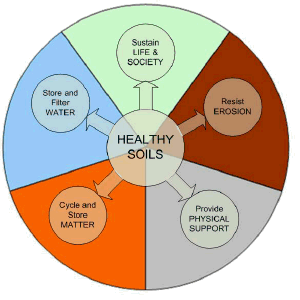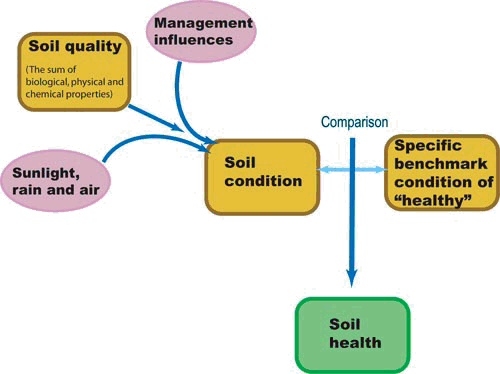What is Soil Health?
Back to Soil health
Soil is our fundamental terrestrial asset. Along with sunlight and water, soil provides the basis for: all terrestrial life; the biodiversity around us; the field crops that we harvest for food and fibre; and, animal products (such as meat, milk, eggs, wool). Soil provides ecosystem services, enables plant growth, resists erosion, stores water, retains nutrients, and is an environmental buffer in the landscape. Soil supplies nutrients, water and oxygen to plants, and is populated by soil biota essential for decomposing and recycling.
Soil health is the condition of the soil in relation to its inherent (or potential) capability, to sustain biological productivity, maintain environmental quality, and promote plant and animal health. A healthy soil is productive, sustainable and profitable.
 | A schematic diagram showing the five major functions of healthy soils.
|
Soil health is analogous to the concepts of environmental health, human health, plant health, and animal health. Human health is a functional concept that describes our capacity to function, to interact with each other and our environment, and to do this into the future.
Understanding, protecting and improving soil health is critical for managing Victoria's natural assets. Soil health fundamentally links to land productivity and environmental sustainability.
A healthy soil:
- Supplies nutrients, water and oxygen for healthy plant growth
- Allows water to infiltrate freely
- Resists erosion
- Stores water
- Readily exchanges gases with the atmosphere
- Retains nutrients
- Acts as an environmental buffer in the landscape
- Resists disease
- Contains a large and diverse population of soil biota
- Is not acidifying or salinising
- Has a range of pore spaces to house organisms, nutrients and water
A schematic diagram showing how soil health is the balance of inherent soil properties, uncontrollable environmental conditions, and management practices.
 | Inputs of the following
|
It is clear that soil management will have a big influence on what level of health occurs.
Soil health postcard
Go out and have a look at your soil
Give your soil a health check
Do you:
- Test your soil regularly to manage inputs?
- Make decisions based on soil conditions (too wet, too dry)?
- Maintain at least 50% ground cover all year round?
- Minimise cultivation and traffic?
- Know how deep crop and pasture roots are growing?
- Walk the paddocks and observe soil conditions?
- Think about how to invest in soil health as part of the farm business?
We provide a downloadable copy of our soil health postcard, this PDF document is provided and should be printed. To view the information PDF requires the use of a PDF reader. This can be installed for free from the Adobe website (external link).
Further information
Soil health for Victoria's agriculture (2007).


